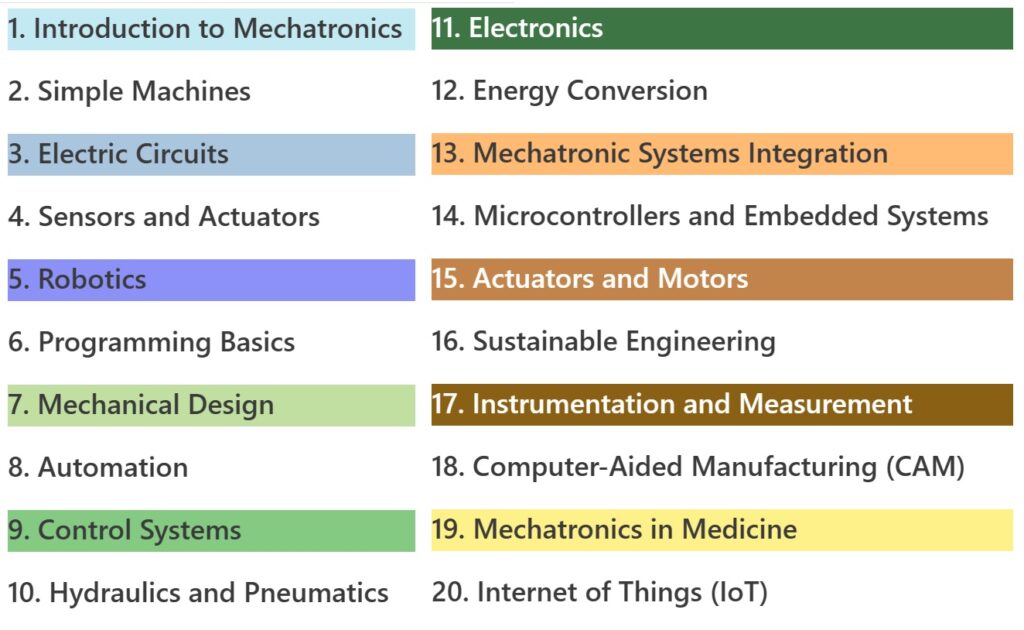Click the simple table below to view the FREE Mechatronics Course for Kids OVERVIEW

This Lessons Contains: READING, VIDEOS, QUESTIONS, and A HANDS ON PROJECT.
Introduction to Mechanical Design
Mechanical design is a fascinating field that encompasses the creation and development of mechanical systems and components. Whether it’s designing a simple household appliance or a complex industrial machine, the principles of mechanical design remain crucial for ensuring functionality, efficiency, and durability.
Key Principles of Mechanical Design
At the core of mechanical design lie several key principles:
- Functionality: The primary purpose of any mechanical design is to fulfill a specific function or set of functions efficiently and reliably.
- Strength and Stability: Mechanical designs must be structurally sound to withstand the loads and forces they will encounter during operation. Factors such as material selection, shape, and arrangement play vital roles in ensuring strength and stability.
- Efficiency: Efficient mechanical designs optimize the use of resources such as energy, materials, and space to achieve the desired outcome with minimal waste.
- Safety: Safety is paramount in mechanical design. Designs must consider potential hazards and incorporate features to mitigate risks to users and the environment.
- Cost-effectiveness: Balancing performance with cost is crucial in mechanical design. Designs should achieve desired functionality without unnecessary expenses.
Effects of Different Shapes on Structure Strength
The shape of a structure significantly influences its strength and stability. For example:
- Triangles: Triangular shapes are inherently stable and distribute loads evenly. Structures with triangular bracing or truss configurations exhibit high strength-to-weight ratios.
- Arches: Arches are effective in transferring loads to supports, making them ideal for bridges and architectural structures. Their curved shape disperses forces outward, reducing the risk of collapse.
- Rectangles and Squares: While rectangles and squares are common shapes, they may not be as structurally efficient as triangles or arches. However, when properly reinforced, they can still provide adequate strength for many applications.
CAD Software and its Role in Design
Computer-Aided Design (CAD) software revolutionizes the mechanical design process by allowing engineers to create, modify, analyze, and visualize designs digitally. CAD software offers several benefits:
- Precision: CAD software enables precise modeling and dimensioning, reducing errors and ensuring accurate designs.
- Efficiency: Design iterations can be made quickly and easily in CAD, speeding up the development process.
- Simulation and Analysis: CAD software allows engineers to simulate and analyze the performance of designs under various conditions, helping optimize performance and identify potential issues early.
- Collaboration: CAD facilitates collaboration among design teams by allowing multiple users to work on the same project simultaneously and share designs seamlessly.
The Importance of Prototyping
Prototyping is a crucial step in the mechanical design process for several reasons:
- Validation of Design: Prototyping allows engineers to test and validate their designs in real-world conditions, uncovering potential flaws or areas for improvement before mass production.
- User Feedback: Prototypes can be presented to end-users for feedback, ensuring that the final product meets their needs and expectations.
- Optimization: Through prototyping, engineers can fine-tune designs to enhance performance, reliability, and user experience.
- Cost Reduction: Identifying and addressing design flaws during the prototyping stage helps prevent costly modifications and recalls later in the production process.
In conclusion, mechanical design is a multidisciplinary field that requires a deep understanding of principles, materials, and technologies. By applying sound design principles, leveraging advanced tools like CAD software, and embracing prototyping, engineers can create innovative and robust mechanical solutions to address diverse challenges in various industries.
Hands on Project for this Lesson
Construct a model bridge using straws and tape, or using anything you like. Research different designs first and try to make it as strong as possible keeping in mind the strengths of different designs instead of the strengths of the material you’ve chosen to work with.
Questions
- What are the key principles of mechanical design?
- How do different shapes affect the strength of structures?
- What is CAD software and how is it used in design?
- Why is prototyping an important step in design?
- Research Question: Look into the design process of a famous mechanical engineer.
Buy me a Coffee
I would be honoured if you’d buy me a digital coffee to express your thanks for this Mechatronics Course I’ve put together to help eager minds excel in their knowledge, learning and success.
Your kind donation makes it possible for me to continue creating amazing content and fulfil my dream of keeping the majority of what I make FREE and Ad FREE!!!
Thank you from the bottom of my heart, and abundant blessings to you!

Join students and professionals
from across the world increasing their knowledge of Electrical Engineering.
One email at a time
We never send spam or give your information to anyone, Privacy Policy here.



